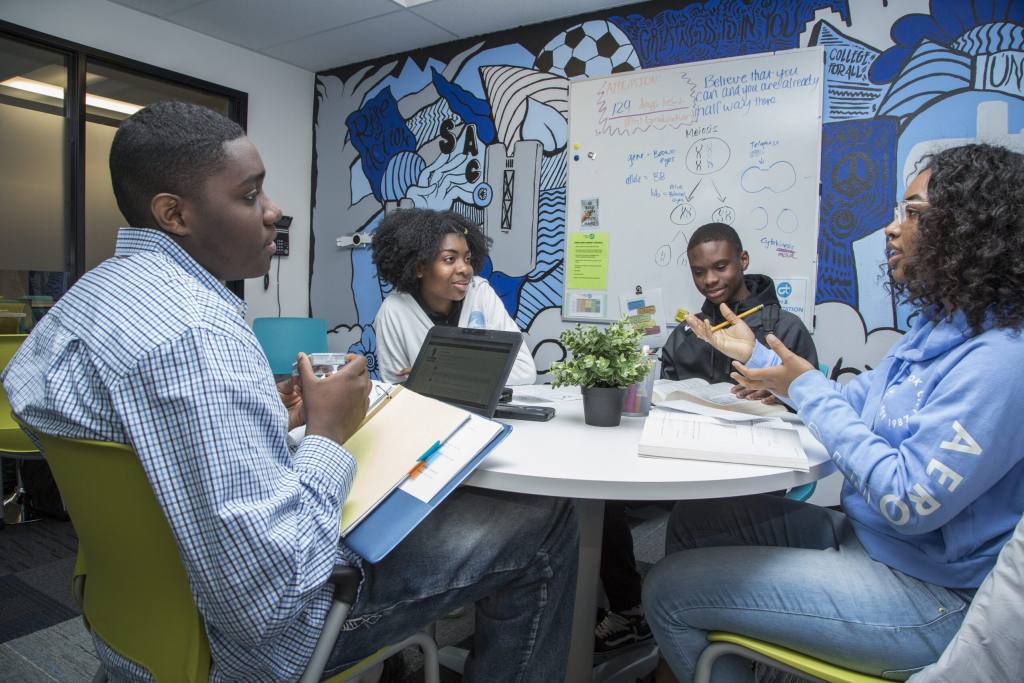Education
Tips To Support Underserved Students

Supporting underserved students is a crucial aspect of fostering an equitable and inclusive education system. These students often face unique challenges that can hinder their academic progress, from limited access to resources to social and economic barriers. Providing the right support can make a significant difference in their educational journey, helping them to succeed and reach their full potential. This guide offers practical tips for educators, parents, and communities to better support underserved students.
Building Strong Relationships
One of the most effective ways to support underserved students is by building strong, positive relationships with them. Many students from underserved backgrounds may feel isolated or disconnected from the school environment. Establishing a trusting and supportive relationship can help bridge this gap and create a sense of belonging.
Teachers and school staff should take the time to get to know their students on a personal level. Understanding their backgrounds, challenges, and interests can provide valuable insights into how best to support them. Simple actions like regularly checking in with students, offering encouragement, and being available to listen can make a significant impact.
It’s also important to involve parents and guardians in the education process. Building a partnership with families can ensure that students receive consistent support both at school and at home. Regular communication between educators and families can help address any issues that may arise and keep everyone aligned on the student’s progress and needs.
Mentorship programs can also be beneficial. Connecting underserved students with mentors who can offer guidance, support, and advice can boost their confidence and motivation. These mentors can serve as positive role models and help students navigate the challenges they may face both inside and outside the classroom.
Providing Access to Resources
Underserved students often lack access to the resources they need to succeed academically. This includes not only school supplies and technology but also extracurricular opportunities and enrichment programs. Ensuring that all students have equal access to these resources is key to leveling the playing field.
Schools and communities can work together to provide students with the necessary tools and materials. This might involve setting up resource centers where students can access books, computers, and other supplies, or providing financial assistance to those who need it. Additionally, schools can partner with local businesses and organizations to offer scholarships, internships, and other opportunities that might otherwise be out of reach for underserved students.
Technology is another critical area where disparities often exist. With the increasing reliance on digital tools for learning, ensuring that all students have access to reliable internet and devices is essential. Schools can provide loaner laptops, offer Wi-Fi hotspots, or work with community organizations to create access points for students who may not have these resources at home.
By addressing these resource gaps, educators and communities can help underserved students fully participate in their education and take advantage of the opportunities available to them.

Culturally Responsive Teaching
Culturally responsive teaching is an approach that recognizes the importance of including students’ cultural references in all aspects of learning. For underserved students, whose cultural backgrounds may not be reflected in the traditional curriculum, this approach can make learning more relevant and engaging.
Educators should strive to incorporate diverse perspectives into their teaching materials and methods. This might involve using literature, examples, and case studies from a variety of cultures, or integrating students’ lived experiences into classroom discussions. Recognizing and valuing the cultural diversity of students can help them feel seen and respected, which in turn can increase their engagement and motivation to learn.
Professional development for teachers is also crucial in this area. Educators need to be trained in culturally responsive practices so that they can effectively meet the needs of all students. This training should cover topics such as recognizing implicit biases, understanding different cultural communication styles, and creating an inclusive classroom environment.
By adopting culturally responsive teaching practices, educators can create a more inclusive and supportive learning environment that resonates with all students, particularly those from underserved communities.
Encouraging Social and Emotional Learning
Social and emotional learning (SEL) is an important component of supporting underserved students. Many students from underserved backgrounds face significant stressors outside of school, such as economic hardship or unstable home environments. SEL programs can help students develop the skills they need to manage their emotions, build positive relationships, and make responsible decisions.
Incorporating SEL into the school day can take many forms, from dedicated lessons on topics like empathy and resilience to integrating these concepts into everyday interactions. Creating a classroom culture where students feel safe and supported is also a key aspect of SEL. This involves setting clear expectations for behavior, encouraging positive peer interactions, and addressing any issues of bullying or exclusion promptly.
Schools can also provide additional support through counseling services, peer support groups, and wellness programs. These resources can help students cope with the challenges they face and build the emotional resilience needed to succeed in school and beyond.
Fostering social and emotional skills is not only beneficial for students’ well-being but also for their academic success. Students who feel emotionally supported are more likely to stay engaged in their learning and perform better in school.
Conclusion
Supporting underserved students requires a multifaceted approach that addresses their academic, social, and emotional needs. By building strong relationships, providing access to resources, adopting culturally responsive teaching practices, and encouraging social and emotional learning, educators, parents, and communities can make a significant difference in the lives of these students. For more strategies and resources on supporting underserved students, visit our website and join the effort to create a more equitable and inclusive education system. Every student deserves the opportunity to succeed, and with the right support, they can overcome the challenges they face and achieve their full potential.
Education
Essential Time Management Tips for Students

Time management is one of the most valuable skills a student can master. Between classes, homework, extracurricular activities, and social life, it’s easy to feel overwhelmed and fall behind. Learning how to organize your time effectively not only helps you stay on top of your responsibilities but also reduces stress and boosts productivity. With the right strategies, students can achieve more in less time and maintain a healthy balance between academic success and personal well-being. In this post, we’ll explore essential time management tips every student should know to make the most out of each day.

Creating a Daily and Weekly Schedule
Creating a daily and weekly schedule is one of the most effective ways to stay organized and manage your time wisely. Start by listing all your classes, assignments, study sessions, and personal activities. Use a planner or digital calendar to block specific times for each task, ensuring that your most important priorities come first. A weekly overview helps you see what’s ahead, while a daily plan keeps you focused on short-term goals. Be realistic, don’t overfill your schedule. Instead, allow flexibility for breaks and unexpected tasks. Consistency is key, so try to stick to your schedule as much as possible. Over time, this routine will become second nature, helping you reduce stress, improve productivity, and maintain a healthy work-life balance.
Avoiding Procrastination: How to Stay Focused and Productive
Procrastination is one of the biggest obstacles to effective time management. To overcome it, start by breaking large tasks into smaller, manageable steps, as this makes them feel less intimidating and easier to begin. Set clear deadlines for each step and hold yourself accountable. Minimizing distractions is also important: turn off notifications, keep your study space tidy, and use focus techniques like the Pomodoro method to stay on track. Motivation plays a big role, too, remind yourself of your goals and the rewards that come with staying productive. Lastly, don’t aim for perfection; taking consistent action is far more valuable than waiting for the “right moment.” By building these habits, you can stay focused, make steady progress, and eliminate the cycle of last-minute stress.
Balancing Study, Work, and Personal Life
Balancing study, work, and personal life can be challenging, but it’s essential for long-term success and well-being. The key is to set clear priorities and boundaries. Start by identifying your most important commitments and scheduling time for each. Use a planner or digital calendar to visualize your week and avoid overbooking yourself. Learn to say no when your plate is full, overcommitting leads to burnout. Don’t forget to schedule downtime for relaxation, socializing, and self-care, as these activities recharge your energy and improve focus. When studying or working, stay fully present and avoid multitasking to make the most of your time. By maintaining structure and allowing room for flexibility, you can create a healthy balance that keeps you productive, focused, and fulfilled in every area of life.
Conclusion
Mastering time management is a skill that empowers students to take control of their academic and personal lives. By setting goals, planning ahead, and staying disciplined, you can reduce stress and increase productivity. With consistent effort and balance, managing your time effectively becomes the foundation for lasting success and fulfillment.
Education
The Evolving Fabric of Society: How Change, Connection, and Culture Shape Our World

Society is a living organism—constantly changing, adapting, and redefining itself through the actions, beliefs, and values of its people. From the earliest tribal communities to today’s hyper-connected global networks, human societies have always reflected both progress and tension. As we navigate the 21st century, the structure of society continues to transform under the pressures of technology, globalization, environmental challenges, and social justice movements.
Understanding these shifts helps us see not only where we are, but also who we are becoming as a collective.
The Changing Nature of Social Connection
A generation ago, communities were defined by geography. People lived, worked, and socialized within tight-knit local environments. Today, digital connectivity has rewritten those boundaries. Through social media, video calls, and online communities, we can connect instantly with anyone, anywhere.
This transformation has brought both benefits and challenges. On one hand, the internet has allowed people to share ideas freely, form global friendships, and collaborate across borders. Activism, education, and even art have all been democratized—anyone with a voice and an internet connection can participate.
On the other hand, this same technology has fragmented attention and sometimes weakened real-world relationships. Digital communication can be powerful, but it often lacks the emotional depth of in-person connection. Social isolation, online polarization, and misinformation have become modern social issues that shape how we interact and perceive reality.
Balancing digital connectivity with authentic human contact is now one of society’s greatest challenges.
Globalization and Cultural Exchange
Globalization has made the world more interconnected than ever. People, goods, and ideas flow across borders at unprecedented speeds, bringing opportunities for cultural exchange and understanding. Music, fashion, food, and technology no longer belong to specific regions—they’re shared globally and reinterpreted locally.
This cultural blending has given rise to what sociologists call a “global society,” where individuals identify not only with their nation or community but with a global human experience. For example, climate change awareness, human rights, and technological innovation are global issues that unite people beyond nationality.
However, globalization also presents challenges. Local cultures sometimes struggle to preserve their identities amid global influences. Economic inequality between nations and communities continues to widen, and the benefits of globalization are not distributed equally.
To build a just global society, the world must find balance—celebrating diversity while fostering shared values of respect, fairness, and sustainability.

Social Movements and the Fight for Equality
Throughout history, societies have evolved through collective struggles for justice and equality. The civil rights movements of the past century have given rise to modern campaigns focused on gender equality, LGBTQ+ rights, racial justice, and environmental protection.
These movements have reshaped societal values, laws, and conversations. Social media has amplified their reach, allowing marginalized voices to be heard globally. Campaigns like #MeToo, Black Lives Matter, and global climate strikes have shown how collective action can drive systemic change.
Yet, progress is not linear. Societies often face resistance from entrenched power structures or cultural traditions. True equality requires ongoing effort—not only in legal reforms but in changing mindsets. Education, open dialogue, and empathy remain critical tools for creating a more inclusive and compassionate society.
As new generations rise, they bring fresh perspectives on justice, sustainability, and freedom, reminding us that social evolution is both necessary and continuous.
Technology and the New Social Landscape
Technology has revolutionized nearly every aspect of social life. From how we communicate to how we work, learn, and entertain ourselves, the digital revolution has redefined social norms. Artificial intelligence, automation, and digital platforms have changed the nature of jobs, education, and even relationships.
Workplaces are shifting toward remote and hybrid models, offering flexibility but also blurring the line between professional and personal life. Education is increasingly digital, giving students access to global resources but also raising concerns about screen dependence and inequality in access.
Social media platforms influence not only personal interactions but also politics and public opinion. Algorithms shape what people see and believe, often creating “echo chambers” that reinforce divisions rather than bridge them.
Technology has incredible potential to empower and connect, but society must use it responsibly. Digital literacy, ethical regulation, and a conscious effort to maintain human values will determine whether technology strengthens or weakens the social fabric.
The Role of Education in Shaping Society
Education is the foundation upon which societies are built. It not only provides knowledge and skills but also shapes values, ethics, and social consciousness. A well-educated society tends to be more tolerant, innovative, and equitable.
Modern education systems, however, face the challenge of preparing people for a rapidly changing world. Beyond academic excellence, schools and universities must teach critical thinking, empathy, and adaptability. These qualities help individuals navigate complex social issues and participate meaningfully in civic life.
Moreover, access to education remains unequal in many parts of the world. Gender disparity, poverty, and geographic isolation continue to prevent millions from reaching their potential. Bridging these gaps is essential for building societies that are fair and inclusive.
Lifelong learning—through formal education, community programs, and online platforms—is becoming the new model for social progress in the knowledge age.
Environmental Awareness and Social Responsibility
The environmental crisis has become one of the defining challenges of modern society. Climate change, pollution, and resource depletion affect everyone, regardless of nationality or status. As awareness grows, societies are rethinking how they live, produce, and consume.
Sustainability is no longer just an environmental issue—it’s a social one. The choices individuals and communities make today will determine the quality of life for future generations. From recycling programs and green energy initiatives to sustainable agriculture and eco-friendly lifestyles, environmental responsibility is now a core aspect of social ethics.
This collective awareness reflects a broader cultural shift: society is becoming more mindful of its impact on the planet. In many ways, environmentalism has become the new social movement that unites people across cultures and political divides.
Diversity, Inclusion, and Modern Identity
Modern societies are more diverse than ever before. Migration, globalization, and evolving social values have brought people of different backgrounds, beliefs, and lifestyles into closer contact. Diversity is not just demographic—it includes differences in thought, ability, gender, and experience.
Inclusion ensures that this diversity becomes a source of strength, not division. When societies embrace inclusivity, they encourage innovation, creativity, and mutual respect. However, achieving genuine inclusion requires more than policy—it demands empathy, open-mindedness, and dialogue.
In today’s world, identity is also more fluid. Individuals are freer to define who they are and how they live, challenging traditional norms. This shift represents both progress and tension, as societies work to reconcile freedom of expression with cultural values.
The Future of Society: Connection, Compassion, and Change
The future of society depends on how we manage change. As technology advances, economies evolve, and global issues intensify, humanity faces choices that will shape the next century. Will we build a society based on competition or cooperation? Isolation or inclusion? Consumption or sustainability?
The answers lie in our collective actions. A healthy society values empathy as much as innovation, and cooperation as much as independence. It listens to its most vulnerable members and adapts to ensure fairness and opportunity for all.
Ultimately, the strength of any society is measured not by its wealth or technology, but by how it treats its people—how it educates, protects, and empowers them.

Conclusion: Society as a Shared Journey
Society is not static—it evolves with every conversation, invention, and act of kindness. The world we live in today is the result of countless human interactions, decisions, and dreams. While challenges like inequality, misinformation, and environmental degradation persist, the potential for unity and progress remains strong.
If we continue to learn from one another, embrace diversity, and act with compassion, society will not just survive the challenges of change—it will thrive because of them.
In the end, society is not an abstract concept. It is us—all of us—working together to build a more connected, just, and humane world.
Education
Innovative Learning Strategies for the Digital Age

The digital age has transformed nearly every aspect of our lives, including education. With the rise of technology, traditional methods of teaching and learning are evolving rapidly, paving the way for innovative strategies that cater to the needs of modern learners. These strategies not only enhance the learning experience but also prepare students for a future that is increasingly dependent on digital literacy. This article explores several cutting-edge approaches that are shaping the future of education.
Personalized Learning Pathways
One of the most significant shifts in education brought about by technology is the move towards personalized learning. Traditional classrooms often adopt a one-size-fits-all approach, but this can leave some students struggling to keep up while others may feel unchallenged. Personalized learning pathways address this issue by tailoring educational content and pacing to meet the individual needs of each student.
With the help of advanced algorithms and data analytics, educators can now create customized learning experiences that adapt to a student’s strengths, weaknesses, and interests. For example, adaptive learning platforms can adjust the difficulty level of tasks based on a student’s performance, ensuring that they are always engaged and challenged appropriately. This approach not only helps to improve academic outcomes but also boosts student motivation and engagement by allowing them to take ownership of their learning journey.
In addition to benefiting students, personalized learning pathways provide valuable insights for educators. By analyzing data on student progress, teachers can identify areas where students may need additional support and adjust their teaching strategies accordingly. This real-time feedback loop creates a more dynamic and responsive learning environment that can better meet the diverse needs of students.
Gamification and Interactive Learning
Gamification is another innovative strategy that is gaining traction in the digital age. By incorporating game-like elements into the learning process, educators can make learning more engaging and enjoyable for students. This approach taps into the natural human desire for competition, achievement, and rewards, making it an effective tool for motivating students.
Interactive learning platforms often use gamification to encourage active participation and collaboration. For instance, students might earn points or badges for completing assignments, participating in discussions, or reaching specific learning milestones. These rewards can be used to unlock new content, access bonus materials, or compete with peers in educational games.
Gamification also fosters a growth mindset by allowing students to see learning as a series of challenges to overcome rather than a set of tasks to complete. This shift in perspective can help students develop resilience and persistence, which are crucial skills for success in both academic and real-world settings.
Moreover, interactive learning tools often incorporate multimedia elements such as videos, simulations, and virtual reality (VR) experiences. These tools provide students with immersive learning experiences that are not only more engaging but also help them to better understand complex concepts. For example, a biology student might use a VR simulation to explore the human body in 3D, gaining a deeper understanding of anatomy than they would from a textbook alone.

Collaborative Online Learning
The digital age has made it easier than ever for students to collaborate with peers, regardless of geographical location. Collaborative online learning platforms enable students to work together on projects, share resources, and exchange ideas in real-time. This approach not only enhances the learning experience but also helps students develop essential teamwork and communication skills.
One of the key benefits of collaborative online learning is the opportunity for students to learn from one another. By working in diverse teams, students are exposed to different perspectives and approaches, which can enrich their understanding of the subject matter. Additionally, online collaboration tools often include features such as shared documents, discussion boards, and video conferencing, which facilitate seamless communication and collaboration.
Collaborative learning also extends beyond the classroom. Students can connect with experts, mentors, and peers from around the world, participating in global learning communities that broaden their horizons and expose them to new ideas and cultures. This global perspective is increasingly important in a world that is becoming more interconnected and interdependent.
Educators can further enhance collaborative learning by incorporating project-based learning (PBL) into their curriculum. PBL encourages students to work together on real-world problems, applying their knowledge and skills to create tangible solutions. This hands-on approach not only reinforces academic concepts but also helps students develop critical thinking, problem-solving, and leadership skills.
Microlearning and On-Demand Education
As attention spans decrease and the demand for flexibility increases, microlearning has emerged as a popular strategy in the digital age. Microlearning involves breaking down complex information into smaller, more manageable chunks that can be consumed quickly and easily. This approach is particularly effective for busy learners who may not have the time or energy to engage in long, traditional lectures.
Microlearning often takes the form of short videos, quizzes, infographics, or interactive modules that focus on specific topics or skills. These bite-sized lessons can be accessed on-demand, allowing students to learn at their own pace and on their own schedule. This flexibility is especially valuable for adult learners or those balancing education with other responsibilities.
In addition to its convenience, microlearning is also highly effective for retention. Research has shown that people are more likely to remember information that is delivered in short, focused bursts rather than in lengthy sessions. By spacing out their learning and revisiting concepts regularly, students can reinforce their knowledge and improve their long-term retention.
On-demand education platforms, such as online courses and tutorials, complement the microlearning approach by providing students with access to a wealth of resources that they can explore at their own pace. Whether learning a new language, developing technical skills, or pursuing a personal interest, students can find high-quality educational content that fits their needs and preferences.
Conclusion
The digital age has ushered in a new era of education, characterized by innovative learning strategies that cater to the diverse needs of modern learners. Personalized learning pathways, gamification, collaborative online learning, and microlearning are just a few of the approaches that are transforming the educational landscape. These strategies not only make learning more engaging and effective but also equip students with the skills and knowledge they need to thrive in a rapidly changing world. To explore more about how these innovative strategies can benefit your educational journey, visit our website and discover the future of learning today. Embracing these new approaches will not only enhance the learning experience but also ensure that students are prepared to meet the challenges and opportunities of the digital age.
-

 Technology2 years ago
Technology2 years agoNew Agriculture Technology in Modern Farming
-

 Food2 years ago
Food2 years agoFighting Restaurant Food Waste with Technology
-

 Lifestyle1 year ago
Lifestyle1 year agoBackpack Essentials for Returning to School
-

 Food1 year ago
Food1 year agoHow to Get Enough Protein Without Meat
-

 Education2 years ago
Education2 years agoInnovative Learning Strategies for the Digital Age
-

 Fitness1 year ago
Fitness1 year agoFueling Your Body for Optimal Performance
-

 Fitness1 year ago
Fitness1 year agoEffective Appetite Control for Enhanced Fitness Results
-

 Food1 year ago
Food1 year agoThe Role of Macronutrients in a Balanced Diet




